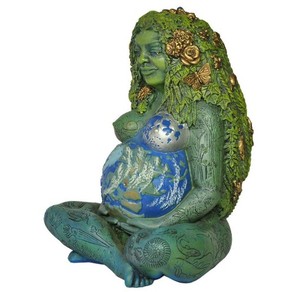(164 products available)






























































































































































































Gaia statues can be made of materials like plaster, artificial stone, or resin.
Plaster Gaia statues
These are the most budget-friendly options. Homemade plaster statues are normally produced using a combination of cement with other materials and sometimes dyed. In terms of production, factory-made plaster figurines are usually cast in molds, while handmade ones are sculpted by hand.
Artificial stone Gaia statues
These pieces are typically produced using a porous material that is then coated with a thin layer of stone-like concrete. They are a step up in quality and cost from plaster and are considered a middle ground by some of their users.
Resin Gaia statues
Plastic resin statues stand up to wear and tear better than plaster or faux stone. Because resin is simpler to mold into fine details, mass-produced resin statues tend to be more detailed than other production methods.
Animal-shaped statues symbolize the spirit found in animals. Some of the common features of the gaia crocodile include:
The colors used in crafting the Gaia statues depend on the material from which they are made.
These are some of the details that can be found in the Gaia statue:
These details serve a functional purpose in the structure of the statue, improving its beauty and meaning.
Gaia statues can be meaningful and useful for people in many situations.
Spiritual practice
Statues of Gaia are often used in individual or community spiritual exercises, reminding people of the divine feminine and nature's power while serving as a focus for contemplation, meditation, or prayer.
Locus for rituals
Rituals may be performed near or with a mother goddess statue, such as offerings, rites of thanksgiving for nature, and ceremonies asking for blessings, fertility, and safe living.
Educational purpose
Gaia statues become valuable resources in teaching about ancient belief, culture, and the interconnectedness of all life on earth.
Art appreciation
Priests may appreciate the beauty and craftsmanship of the Gaia statues as a form of artistic expression, which will lead to a better understanding and respect for the various forms of art created by different people in the world.
Community building
Goddess statues act as a source of unity among people who share similar beliefs in the importance and worship of the divine feminine, leading to groups, circles, or festivals centered around the veneration of Gaia.
There are several types of Gaia figurine that serve different purposes when choosing the Gaia statue.
If the mother matrix statue will be used for spiritual or religious practices, one should look for details that are crafted in or appropriately colored for the ritual. Also, consider the size, as larger statues are useful for group activities, while smaller ones are suitable for personal worship.
In cases where the female figurine is required for aesthetic purposes or as art, focus on the artistic quality and the material used. The Gaia and kali statue can be made of resin, faux stone, or plaster. Often, it's more about whether the artist put in the work or not than the material itself.
The crafted detail of the statue can be symbolic and may serve the same purpose in other cultures. It is therefore important not to ignore any symbols.
Aspects like indoor or outdoor placement are important, as other statues can be used indoors but would be appropriate for outdoor use because of their weatherproof features.
Gaia has different maintenance needs depending on the material.
Plaster statues
These are often the cheapest ones and are easy to maintain. Plaster shrines are recommended to be wiped clean with damp clothes, while those painted should avoid direct sunlight to prevent bleaching and crack formation. Should a gaia statue repair be needed, it should be done using plaster in the case of a small repair. For bigger two pieces, a professional should be called. A different part should be used for each of the statue repairs so that the statue retains the original shape as much as possible.
Artificial stone statues
In most cases, artificial stone statues are more robust than plaster. Individuals should interfere with the statues by gently washing them with soapy water. Also, the statues should be routinely sealed to protect the finish. Minor cracks can be fixed with epoxy resin, while major fractures might require the help of a professional.
Resin statues
Resin models usually resist the weather, but harder resin can chip if struck. Clean using mild detergent and rinse well. Wear and tear can be fixed with glue, but pieces that are broken should be addressed by a professional.
A1: Gaia statues promote the reverence of nature and the need to treat the environment gently.
A2: Common themes found in Gaia and kali statues include fertility, nature, renewal, and the cycle of life.
A3: In ancient cultures, they regarded Gaia as the personification of the Earth and the mother of all life.
A4: Gaia sculptures are commonly made from stone, bronze, wood, or clay.
A5: They can participate in rituals, spend time in nature, or meditate.